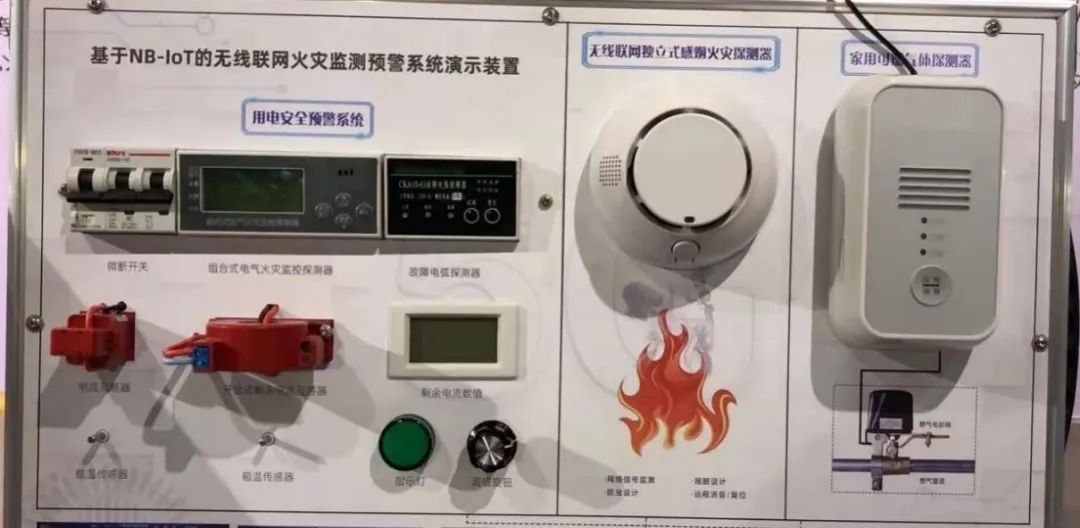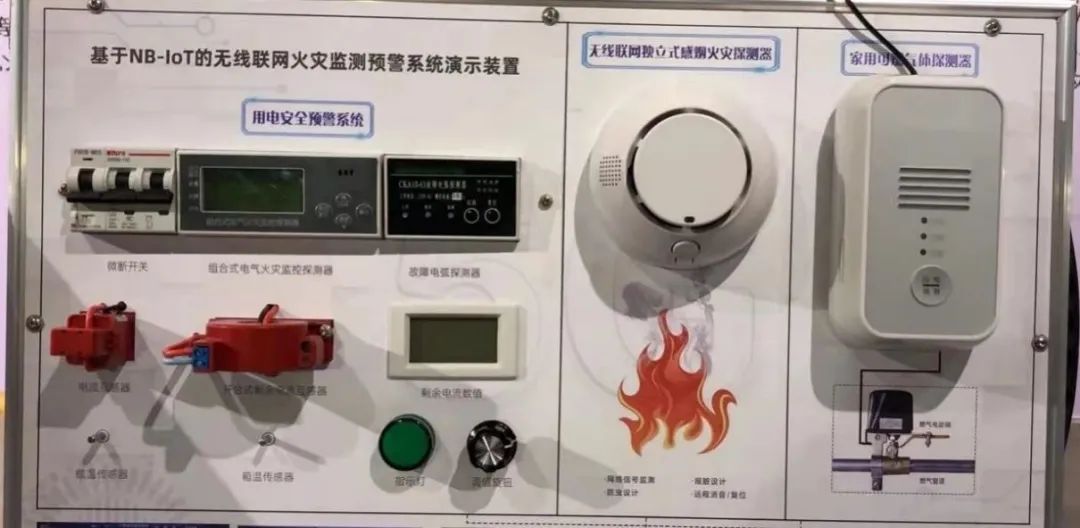

Introduction: The NB-IoT based smart fire early warning system consists of perception layer devices, NB-IoT network, a wireless connected fire warning monitoring platform, and terminal apps. It aims to address the lack of effective fire warning and prevention measures in residential homes and “nine small places” where fire safety is inadequate. 
(1) Overview of Achievements: The NB-IoT based smart fire early warning system includes perception layer devices, NB-IoT network, wireless connected fire warning monitoring platform, and terminal apps. The perception layer devices include standalone smoke detectors with wireless connectivity, standalone temperature fire detectors, standalone combustible gas detectors, and standalone electrical fire monitoring detectors. This system is designed to solve the lack of effective fire warning and prevention measures in residential homes, “nine small places”, shared spaces, cultural heritage buildings, and ancient towns. It comprehensively senses and analyzes parameters such as fire, electricity, gas, water, video, and environmental conditions in protected locations, enhancing the fire warning detection capabilities, battery life, alarm timeliness, and operational stability of the wireless connected fire warning system.
Contact Person: Wang Zhuofu
Contact Number: 15640518123
Achievement Images:

(2) Functional Features:
1. Standalone fire detectors are resistant to insects and dust pollution;
2. Fire alarm verification logic and remote video fire confirmation;
3. The standalone fire detectors have network signal quality monitoring capabilities;
4. Suitable for monitoring electrical fires in operational sites using open and closed residual current sensing technology;
5. Multiple information push methods including voice calls, SMS, and apps;
6. The platform implements grid-based permission management;
7. Low power consumption and long battery life for wireless connected devices;
8. Simple installation of devices and low system deployment costs;
9. High reliability for large capacity networking of perception layer devices.
(3) Performance and Technical Parameters:
1. The time for fire warning/alarm information from the standalone fire detector to be transmitted to the monitoring platform: <30s.
2. The time for alarm notifications for issues like detector removal or low battery: ≤100s.
3. The time for offline fault alarm notifications from the standalone fire detector: ≤24h.
4. Information push time: ≤10s.
5. Battery lifespan: ≥3 years.
Comparison with Similar Domestic and International Equipment:
1. Based on NB-IoT narrowband cellular public network, combined with battery optimization technology, this system enhances network scale, sensitivity, and coverage, balancing low power consumption needs.
The system effectively resolves the issue where standalone fire detectors can only alarm locally, and the alarm signals cannot be transmitted remotely. Additionally, based on authorized frequency band cellular public networks, the channels are clean, reducing investment costs, and ensuring high network reliability and stability. In urban environments, the system capacity can be expanded to tens of thousands of points, with communication distances reaching kilometers, capable of communicating through a reinforced concrete wall, with battery life exceeding 3 years.
2. Based on multiple information interfaces and hierarchical permission settings, the system meets the actual fire prevention needs of residential areas, small places, shared spaces, and temporary buildings.
The system cloud platform can integrate various standalone fire detection and early warning information, with functions for information access, processing, and hierarchical permission-based alerting, and it features interfaces for linkage with video monitoring systems, utilizing video resources for auxiliary fire confirmation.
Comparison with Existing Domestic and International Systems:
|
Comparison Item |
This Achievement |
Existing Domestic and International Systems |
|
Compliance and Reliability |
Completed NB-IoT compliance testing, wireless performance testing, obtained network access permit, fire product certification |
Insufficient testing in aspects such as radio performance and compliance; some products lack network access permits and are illegally connected |
|
Alarm Push Function |
Reliable emergency alert push; multiple reminders via app, SMS, and phone during alarms to prevent missed alerts, with delivery confirmation |
Only has single push function via app, SMS, or phone |
|
Integrated Types of Detectors |
Diverse product range covering all monitoring means related to water, electricity, fire, gas, and video surveillance for residential and small places, allowing for customized deployment and creating a multi-layered defense; includes open and closed electrical fire monitoring without needing to cut power or network |
Relatively limited types; insufficient consideration of protection objects, environmental features, and application scenarios; installation of electrical fire monitoring requires cutting power, affecting existing building operations, leading to user resistance |
|
Mobile Mute Function |
Practical function: has mobile mute function after alarm, close to ordinary users |
Requires user to press the mute button on the detector, with poor user feedback |
|
Network Signal Monitoring Function |
Strong network performance applicability, has network signal quality monitoring function |
Manufacturers and operators find it difficult to delineate responsibilities when network issues arise |